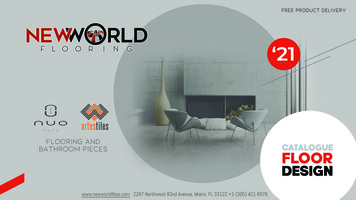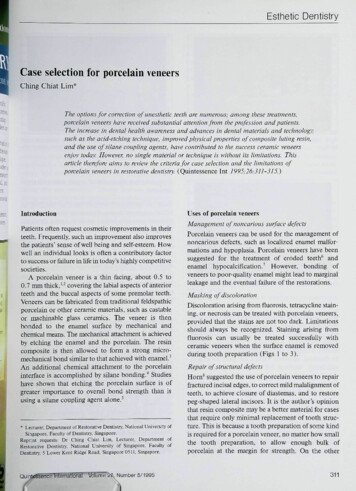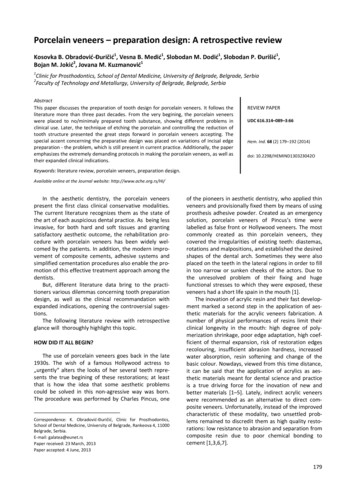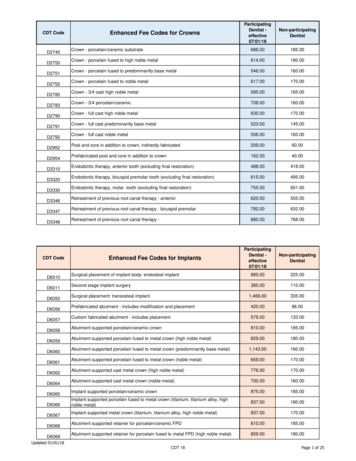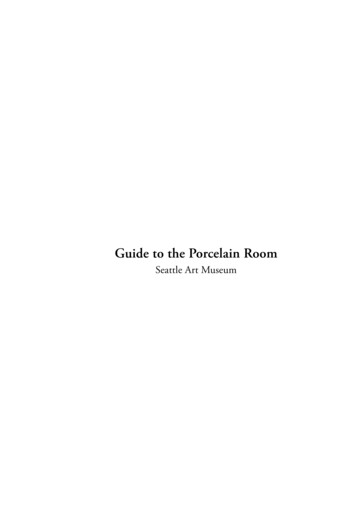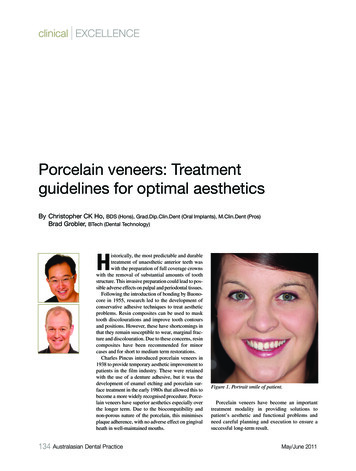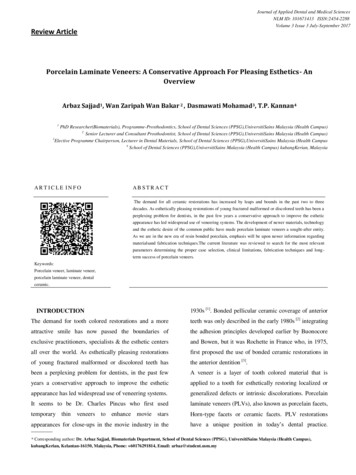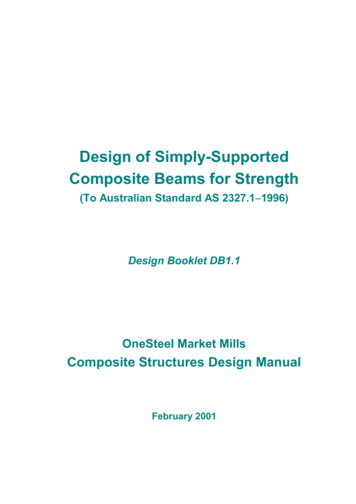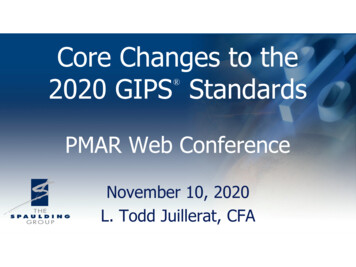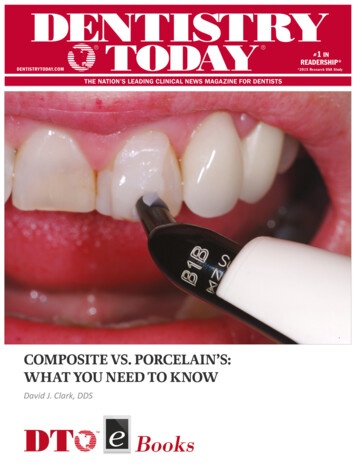
Transcription
COMPOSITE VS. PORCELAIN’S:WHAT YOU NEED TO KNOWDavid J. Clark, DDS
April 2017CONTENTSCHAPTER 1 Young Patients and FracturesDirect composite restorations have a new role in new applications in conservative aesthetic dentistry.CHAPTER 2 The 360 Composite Resin VeneerI njection overmolding gives direct composite restorations a new role in the reconstruction of anteriorteeth.CHAPTER 3 Modern Management of Deep Caries Two cases illustrate how the Modified Hall Technique can effectively address caries in a single visit.ABOUT THE AUTHORDAVID J. CLARK, DDS2Dr. David Clark founded the Academy of Microscope Enhanced Dentistry, an international associationformed to advance the science and practice of microendodontics, microperiodontics, microprosthodontics, and microdentistry. He is a course director at the Newport Coast Oral Facial Institute in NewportBeach, Calif. He also is co-director of Precision Aesthetics Northwest in Tacoma, Wash, and an associatemember of the American Association of Endodontists. He lectures and gives hands-on seminars internationally on a variety of topics related to microscope-enhanced dentistry. He has developed numerousinnovations in the fields of micro dental instrumentation, imaging, and dental operatory design. Dr.Clark has authored several landmark articles about microscope dentistry including “Aesthetic Dentistry,” “Sealants,” “The Role of Ultrasonics in Three Dimensional Shaping and Restoration of Non VitalTeeth,” “Micro-Imaging and Practice Management,” and “Crack Diagnosis.” He is proud to join with CRA(Clinical Research Associates) in the “Update Series” lectures and to participate in the important researchat its world class facility in Provo, Utah. He was the editor in chief for the 2005 launch of The Journal ofMicroscope Dentistry. He is one of the pioneers of the microscope in restorative dentistry and was the firstto install ceiling tracks to facilitate the use of a microscope in more than one operatory. And, he is theowner of Bioclear Matrix Systems. He can be reached at drclark@microscopedentistry.com.
Chapter 1Young Patients and FracturesInjection overmolding of teeth using the Bioclear Method1 is chang-full-coverage crown. By the second or third go-round, there is almost no toothing the way that we do composite restorations, and more importantlyleft. In this case, we see the tragic state of affairs 20 years after the maxillarychanging the way that we think about restorative dentistry. (A short vid-central incisors were restored, re-restored, and re-restored again with ceramiceo showing the clinical steps of case 1 is available at the Bioclearmatrix web-crowns; all following a traumatic incident accident in this patient’s collegesite, YouTube, and in the Dentistry Today web video library.)days (Figures 7 and 8). Originally, he experienced incisal-third fractures ofteeth Nos. 8 and 9. Remember that we cut up to about 72% of the tooth awaywhen we do a conservative full-coverage ceramic crown. And with each retreat-CASE 1If you think only porcelain, not composite, can permanently restore an incisal edge, think again!In the first case (Figures 1 to 4), we see a series of photographs of a peg lat-ment throughout the decades, this poor patient’s teeth just get smaller andsmaller. When the patient, Dr. Mark Konings, experienced yet another failederal restored with injection overmolding. Because itis monolithic and injection-molded (not hand-lay-Table. Achieving the New Super Strong Overmolded Composite RestorationPlacement TechniqueInstead of hand spatulation and layering to grade on theincisal edge (“grade” is the native or planned additive finalcontour of the external of the tooth; it is a landscaping termadapted for restorative dentistry), intentional excess isinjected against the tooth-Bioclear Matrix complex, similar topressed porcelain, and the injection zone is then ground backto grade similar to milled porcelain.Incisal Thickness Inciso-Gingivally1.5 mm minimumIncisal Thickness Bucco-Lingually2.0 mm minimumered), it looks as smooth and beautiful as a porcelaincrown in the 5-year follow-up photo (Figure 5). Furthermore, because properly injected composites canbe thinned down to a 20- to 30-μm gingival margin,the health of the soft tissues and aesthetic pinknessis better than it would look next to a less-than-perfect porcelain margin (Figure 6).Now before we go any further, the reader shouldnote that this author also uses porcelain and gold to restore teeth. However,set of crowns, he came to me with this dilemma. Even though the treatmentsafter 22 years of microscope-enhanced ceramics, I have observed that thewere done carefully each time by skilled and caring clinicians using state-of-soft-tissue response of a 200-μm ceramic margin is no match for a 20-μmthe-art techniques, the eventual outcomes were not good ones. Throughoutinfinity edge composite margin.2 And many crowns done today have openthe years, the crowns on the upper arch wore down the enamel on the lowermargins of 1,000 μm or more, CAD/CAM or not. And no, resin cements don’tincisors, and subsequently ground down some more by his dentist to make“close” the margins. Porcelain is an excellent choice in many situations, but isclearance and draw to place porcelain veneers. Those preps were mostly inno longer the only choice, nor always the best choice today, in the new worlddentin at that point, and almost into the pulp.of monolithic injection overmolded composites.The treatment for case 2 involved opening the vertical dimension of occlusion (VDO) with a unique and straightforward technique that is taught inCASE 2If you think that patients don’t mind having their teeth grounddown for porcelain, think again!One of the worst things we can do to a young maxillary incisor is to place a3the level 3.2 course at the Bioclear Learning Center (Tacoma, Wash). I placedcomposite overlays on the blasted (with aluminum tri-hydroxide [BioclearBlaster]), etched, and unprepared posterior teeth of the lower arch. Next, the
patient’s maxillary lateral inci-CASE 1sors were overmolded with Bioclear 360 direct composite resinveneers using two A103 SmallIncisor Matrices (Bioclear) (oneon the mesial and one on thedistal) (Figures 9 to 11). Once theBioclear 360 composite veneerswere finished on the lower inci-Figure 1. Pre-op view of a peg lateral.Approximately 7% of the population has apeg or undersized lateral incisor. A heavyrubber dam created an ideal environmentto retract the soft tissue and to seal themargins of the Bioclear matrices.Figures 2 and 3. Two Bioclear DC-202 matrices were placed, and the initial “hips” of flowable composite placed, approximately 2.0 mm in height. After light curing, delayed wedgingusing the atraumatic Diamond Wedges was done.Figure 4. Immediate post-op view of the peglateral showing a “porcelain-esque” densityand polish to the monolithic composite.Figure 5. A 5-year follow-up photographdemonstrates that injection overmoldedcomposites can stand the test of time, evenwhen restoring incisal edges.sors, the crowns were removed(Figure 12), abutments strengthened (Figure 13; this techniqueis explained in the level 6.0 Bioclear Learning Center AdvancedMicro-Endodonticscourse)then impressed (Figure 14), andFigure 6. Pre- and post-op radiographs ofa typical peg lateral treated with injectionmolding of composite with a BioclearDC-201m matrix.CASE 2photos were taken to allow theceramist to easily match the layering ceramic to the composite.Replacement of the crumblingand mostly de-bonded lowerveneers was done in the sameFigures 7 and 8. Preoperative view of the chipping maxillary crowns and crumbling lowerporcelain laminate veneers. It all started 20 years ago with 2 chipped teeth.Figure 9. In contrast to “amputative” dentistry, additive dentistry was done. Note howthe two A-103 Small Incisor Matrices (Bioclear) also served to control the placementof the 37% phosphoric acid gel etchant.Figure 10. The lower incisors are shownhere after injection molding and beforeA-103 matrix removal.Figure 11. Bioclear Matrix Selection chart.Figure 12. Once the failing porcelain wasremoved, the expected yet tragic toothvolume condition was noted.Figure 13. The teeth have had ferruleresurrection and frustum preparations thatwill significantly reduce the risk of snap-offfracture by redistributing the stresses.Figure 14. Pressed lithium disilicate (IPSe.max [Ivoclar Vivadent]) crowns werecemented (RelyX Luting Plus [3M]) after blasting the prepared teeth with gentle aluminumtri-hydroxide and a Bioclear Blaster.Figure 15. Final postoperative view of themixed composite/porcelain case demonstrating predictable and simple colormatching.manner, with Bioclear 360 overmolded composite veneersand, because the VDO hadbeen opened, I had the luxuryof not grinding yet another 2mm off of the patient’s alreadybeat-up lower incisors. Becausethe lower teeth lacked naturalcontacts once the veneers wereremoved, the treatment of thelower arch with composite overmolding was significantly morechallenging than the maxillarylateral incisors. Because Markwas distraught about all of the4
loss of tooth structure, directly resultant from the dentist’s decision to grind hisfront teeth down decades before, he was insistent on doing the least invasiveapproach, and he did not want additional ceramic restorations. Therefore, thechallenge of managing Bioclear Matrices without the aid of natural contactswas met, albeit with logistical complexities.In the final postoperative view, one can see the match between the maxillarycentral incisors restored with pressed lithium disilicate crowns (Shade A-2) (IPSe.max [Ivoclar Vivadent]) crowns, cemented with a resin modified glass ionomercement [RelyX Luting Plus [3M]); and overmolded composite on teeth Nos. 7, 10,and 22 to 27 (Figure 15). Monolithic composite resin (Filtek Supreme Ultra [3M];A-2 body shade) was used with 90% of the volume in regular (paste) compositeand approximately 10% Filtek Flowable (3M). A properly warmed (HeatSync [Bio-Figure 16. Drs. David Clark and Mark Konings shown teaching at Bioclear LearningCenter.placement techniques.clear]) composite resin will flow into the nooks and crannies and gingival marginAt the Bioclear Learning Center, the principles and fundamentals of ante-areas where the matrix-tooth interface is at too acute of an angle to reasonablyrior tooth reconstruction are taught that render a composite resin restorationinject room temperature paste composite.nearly as bulletproof as the new strong, monolithic all-ceramics. Composite’sWe cannot turn back the clock and undo what we did 20 years ago. Today isfracture toughness (3 point bend) is less than porcelain; however, and therefore,a new day! In this case, the patient realized that the next likely step for his tinythe placement techniques employed require strict adherence to the parameterslower incisors was to grind them down to make clearance and draw to receivefound in the Table.all-ceramic crowns, which was his only real choice using traditional means. HeWith the Bioclear method, there should be little to no hand manipulation ofunderstood, because of his high dental IQ, that he faced the real possibility thatthe composite. Instead, a balance of heated flowable and heated paste compos-the next failure would cause him to lose all of his lower incisors. And his 2 max-ite is injected into the tightly fitting and anatomically shaped Bioclear matrices.illary incisors were right behind them in this legacy of “amputation” dentistry.Because the matrices are surprisingly thin at 50 μm, tight contacts are possibleDentists are afraid to change. And we love porcelain. In the author’s opinion,without wedging. Most dentists are pleasantly surprised that there is rarely anwhen a patient walks into the office today with a fractured incisor, injectionoverhang created in the interproximal. This is due to the tight fit and precise ad-overmolding using a composite resin should be a first choice when indicated,aptation of the matrix, combined with the ideal controlled injection pressure ofnot a full-coverage ceramic crown.heated flowable composite plus heated regular (paste) composite.(An interesting side note on our patient in case 2: Dr. Mark Konings has a PhDTo fully understand the global implications of the composite versus ceram-in chemistry, is an expert in composite chemistry, works for 3M, and is a facultyics debate, the reader needs to understand a few key issues. First, prosthodon-member of the Bioclear Learning Center, helping to teach the very techniquestists have traditionally steered the thinking of the dental schools and privatethat we utilized to help save his badly damaged dentition.)teaching institutes toward what is considered “permanent” and away fromwhat is “temporary.” For example, if you take advanced coursework at many ofIf You Think Composite is Weak, Think Again!the established institutes in the United States, they are usually run by a notedMost dentists are shocked that the compressive strengths of monolithic (sameprosthodontist. These courses are organized, carefully thought out, and wellmaterial, nonlayered) lithium disilicate ceramic and monolithic compositetaught. However, they are ceramic-centric. Most prosthodontists have very lit-are essentially the same. It does not make any sense, at first, because we seetle confidence in composite resins as a 20-year modality. Not surprisingly, theso many anterior composites that chip, break, and stain. The truth is thatfew composite courses that they offer are either fussy artistic layering coursestraditional composites are weak because they are made weak using outdated(where you spend 6 hours to build a central incisor), or sometimes discussing5
the use of composite as a temporary fix while you wait to do the “real thing” (ie,CLOSING COMMENTSan all-ceramic restoration). At our learning center courses, we often welcomeWhenever I give a hands-on course, I like to start with the following story:prosthodontists (as attendees) who are intrigued by the role of composite asboth a permanent and transformative dental material.A 12-year-old girl accompanied her mother and her dentist to an AGD sponsored all-day hands-on course teaching the Bioclear method. The mom had askedThe second key issue is that dental clinicians in the rest of the world (otherme if it was okay for them to attend the course with their doctor. Well, I did herthan the United States and Canada) often tell me that North Americans “muti-one better! When the course was ready to begin, I handed the young girl a dento-late” teeth and “throw crowns at nearly every tooth” we see. Clinicians inform, matrices, instruments, a composite heater, and said, “Do the exercises andEurope, South America, Asia, and elsewhere place far fewer ceramic full-cover-have fun.” At the end of the course, the 12-year-old girl brought her dentoform forage crowns and a lot more composite resin restorations. Why? Several reasons.me to critique her 3 exercises. How do you think she did? She knocked it out of theMost of the rest of the world does not have an insurance-based model for reim-park! Modern composite techniques, such as the Bioclear method, can be easy tobursement. In the United States, we are rewarded when we do a crown becauselearn if you forget pretty much everything that you have been taught, start over,the insurance fee is generally 4 times higher for a crown—approximatelylisten carefully, study basic engineering, and follow directions exactly. And, it can 1,000 for a crown versus 250 for a composite. If you take insurance out ofbe just as profitable as placing all-ceramic restorations.the picture, the composite resin option becomes far more important. Habit isIt may be quite some time yet before mainstream dentistry learns and adoptsalso at work in the overall makeup of clinical choices being made. Europeansmodern composite technique. However, a small and rapidly growing segmentdo significantly more large composites in lieu of crowns and therefore honeof dentists internationally are embracing this patient-friendly and predictabletheir skills. And they take pride in being conservative. Europe’s biggest prob-technique. Due to word of mouth, an online presence, and information via otherlem is an obsession with layering that creates a weaker, more porous, and moremedia, patients are beginning to ask for the Bioclear method. Perhaps it will beexpensive composite than necessary. In the end, Europe’s composite resin res-patient demand that will jumpstart this new revolution in conservative patienttorations (due to complicated placement techniques) are leaking, staining, andcare?Fbreaking, just like ours.References1. Kwon SR, Oyoyo U, Li Y. Influence of application techniques on contact formation and voids in anterior resincomposite restorations. Oper Dent. 2014;39:213-220.2. Clark DJ, Kim J. Optimizing gingival esthetics; a microscopic perspective. Oral Health. 2006;96(4):116-126.6
Chapter 2The 360 Composite Resin VeneerShould full crowns be a last choice when considering reconstruction of anterior teeth today, rather than a first choice? In Figure 1,we see a catastrophic failure of a ceramic crown doneusing a “conservative” crown preparation design.Magne and Belser1 have demonstrated the extremetensile stresses present in the palatal cemento-enameljunction (CEJ) area in a virgin incisor when the toothis loaded. Any axial reduction in the palatal CEJ areaFigure 1. A catastrophic snap-off failure just 8 years afterwhat appears to be a conservative axial reduction prephad been cut. (Image courtesy Dr. Jihyon Kim, MercerIsland, Wash.)Figure 2. Bioclear 360 veneer matrix. Currently sold asa 6-tooth kit (12 matrices), the notched gingival portionallows deeper seating and is comfortable to the patient.is crippling to the maxillary tooth because the already high stresses naturally present in this area aregreatly multiplied. This is a problem even when theaxial reduction is minimal; ie, 0.5 mm. Throughouttime, with constant masticatory function, stress corrosion occurs in the palatal dentin until eventuallythe crown can suddenly snap off at the gumline. ThisFigure 3. Before and after images of a now-happypatient.results in an irretrievable failure in most cases with the need for a subsequentpost-ortho adult cases.extraction. Ask yourself, how would you feel if your central incisor snappedThe many shapes andoff today at lunch?sizes allows for a widevariety of applications.THE DIRECT BIOCLEAR360 COMPOSITE VENEER/CROWNThe ultrathin width ofFigure 4. Monolithic Overmolded Composite restorations contrasted with the before image of “patchwork”composites.The Bioclear Matrix System was introduced in 2007. A Diastema Closurethese matrices allow for a tight contact without using wedges in many cases.Matrix process patent and a Restoratively Driven Papilla Regeneration patentThe next generation of the Bioclear Matrix is significantly stiffer. The Bioclearwere granted by the US patent office in 2013. The Injection Molding ProcessVeneering Matrix is 75 μm and is as strong as stainless steel (Figure 2). It comes in apatent was granted in 2015 by the US patent office to overmold teeth with akit with a paired 2-part (mesial and distal) matrix that snaps around anterior teethbalance of heated flowable and heated (regular) paste composite.to allow easier reconstruction of teeth when no diastemas or large black trian-The original Bioclear Matrix is remarkably strong in spite of only beinggles are present. It comes in a 12-piece, canine-to-canine kit. The anatomic shape50 μm thick. This gauge of mylar (which is the same as old-fashioned, flatallows the matrix to seat easily into the sulcus without bleeding. Interproximalmylar strips) is popular for anterior composites such as Class III restorations,scallops account for the presence of the papilla (patent pending). Heated compos-closing diastemas, treating undersized and peg laterals, and eliminatingite is injected into the forms once the tooth has been prepared. Preparation of thethe “dreaded black triangle” present in 30% of adults and probably 75% oftooth involves blasting off biofilm, lightly sanding the contacts with True Contact7
Figure 5. Retracted preoperative viewdemonstrating multiple aesthetic problems.Figure 6. Oblique view shows the rotatedlateral incisor that needed to be reduced onthe mesial aspect. (Note: This was the onlyarea that required aggressive reduction.)Figure 7. Occlusal photograph reveals thatwe had ample space on the central incisorsto add enough thickness of composite resinto successfully hide the dark color of theteeth without amputating tooth structure.Figure 9. The old restoration has beenremoved from just the one incisor. Thisallows me to not lose the landmarks andhave trouble later with symmetry andmidlines.Figure 10. The set of Bioclear360 Veneermatrices was seated and trimmed.Figure 11. The 37% phosphoric acid wasinjected into the forms and was wellcontrolled during etching and rinsing.Figure 8. Filtek Supreme Ultra (3M) (shadeB1 body) was placed on the tooth for patientshade approval. Remember to keep the teethwet during this time to avoid color confusion.Also, make certain the composite is lightcured before showing the patient, as mostcomposites get brighter after curing.Figure 12. Incisal view of the completedinjection shows a palatal and facial “umbilical cord” (intentional composite resinexcess) that was left undisturbed until afterlight curing.Table 1. The Bioclear360 Veneer Versus Porcelain for Anterior TeethFigure 13. Facial view of the intentionalexcess.Figure 14. Once the right central had a roughshape, the left central incisor was disassembled and restored.sanders, and removing any decay and/or old restorative material. There are severalunique advantages to both the patient and the clinician (Table 1).CASE REPORTNo tooth structure needs to beremoved for path of insertionDraw is needed to seat porcelain. Thisresults in up to 75% of the volume of toothbeing cut away.Single-appointment restorationsPatients must return for a secondappointment unless the doctor has amilling machine. If the doctor has a millingmachine, the milled veneers cannot bemade as thin as pressed veneers, requiringheavy tooth reduction.Composite can be thinned to a 20μm infinity edge at the gingivalmarginMany porcelain crowns and veneers causemild gingival inflammation resulting inunaesthetic red or cyanotic tissue. Marginalgaps of 200 to 1,000 μm are the norm.Most composites wear at the samerate as enamelPorcelain is more abrasive than enamel,and during a lifetime, it takes its toll onopposing natural teeth.Table 2. Injection Overmolded Composite Versus Traditional CompositeA female patient presented for her new patient examination recently. She wasBioclear360 OvermoldedVeneers/Crownsreferred by her daughter, Sarah, who is an excellent hygienist in our office. TheCompressive strength of monolithiccomposite is nearly as strong as milledlithium disilicate (IPS e.max [IvoclarVivadent]).Layering, especially hand layering, createsa phenomenon described as “seaming,”which creates an inherently weakerrestoration.Stain resistance is excellent, but aminimum of training is key to achievethe super shine evident in the post-opphotos.Hand-placed composites often lookacceptable on the day of placement, butare notorious for stain. After a few months,interproximal margins all begin to stain.The Bioclear Method is now beingrequested by patients.Direct bonding has a bit of a bad name.Check out what dentists and patients sayabout it on the Internet.patient was on a limited budget and requested that 2 of her old and yellowingcomposite resin fillings be replaced. After reviewing her photographs with her,at the consultation appointment, I suggested that replacing old fillings alonewas not going to make a significant impact on her overall smile (Figures 3 to 5).Instead, I recommended 5 Bioclear360 veneer restorations. It should be notedHand-Layered CompositeVeneersthat orthodontics and porcelain reconstruction were also discussed with thepatient, but she declined those more extensive, expensive, and invasive options.teeth would need to be sacrificed to be able to create uniform coverage withcomposite resin. In this patient’s case, the mesial of the right lateral needed toClinical Protocolbe reduced (Figures 6 and 7). I generally use shade B1 body Filtek Supreme UltraThe first step of the procedure was to determine if any prominent areas of the(3M) for most cases, which can be seen in Figure 8 being tried in and light cured8
Figure 15. The Bioclear HeatSync unit. Thiswarming unit creates ideal thermal liquefaction of composite heated to 155 F.Figure 16. Postoperative view reveals anideal smile architecture as the smile-linefollows the shape of the lower lip.Figure 17. Postoperative oblique view.Figure 18. Retracted postoperative viewwith the ideal combination of pink and white:healthy pink tissue, minimal amputation oftooth structure, and ideal shapes that eliminate black triangles.on the tooth for patient approval. Next the teeth were disclosed (Bioclear dual-raves about the benefits realized by doing this additional step (Figure 15). Sim-color disclosing agent) and then blasted carefully to remove biofilm (Bioclearply put, to make composite resin as predictable as porcelain, heating is a must.Blaster). Minor bleeding often occurs during this procedure, and this can be eas-Heated composite has been around for a long time now, nearly 20 years. Untilily controlled with the use of Astringedent (Ultradent Products). Old restorationswe started injecting composites recently, there was no real urgency to use heating.were removed and all sharp areas were rounded. Long bevels are also helpful.Now it is a must. Composite is safe to the pulp and soft tissue because compositeIncisal edges can be predictably restored if certain guidelines are followed. (Seeacts like a thermal insulator. It has low specific heat, like popcorn. It can be verypart 1 of this ebook, which outlines the requirements to predictably restorehot, but it doesn’t burn you. On the other hand, metals have high specific heat.incisal edges with composite resin.)That is why any heating of metal instruments that are to be used in the mouth isNext, the teeth were restored one at a time to achieve tighter contacts (Fig-to be avoided.ures 9 to 14). Intentional excess was left at the injection zones, while the criticalinterproximal and sugingival areas needed little to no finishing. Each tooth hadWHAT IS THE SCIENCE BEHIND THE BIOCLEAR METHOD?a gross shape, but final shaping was done with coarse discs (Sof-Lex ET [3M]).There was recent research showing that the Bioclear Method was significantlyFinally, the 3-step polishing technique was done to achieve a mirror finish thatfaster than the Mylar Pull Technique and resulted in 100% of the samples withrivaled porcelain for brilliance. (A brief narrated video of the procedure is postedan ideal contact, versus only 80% with the Teflon technique.2 Additionally,on YouTube, the Bioclear Matrix website or at the Dentistry Today website. It isthere are multiple studies demonstrating that composite can be heated fortitled “Bioclear360 Veneer.” Details of the 3-step “rock star” polish are also inextended periods without any negative affects to the composite.this video [Table 2]).Final views of the case show the mixed porcelain and Bioclear360 Veneerssmile. A common sight: the composite teeth have tissue that is healthier, pinker,HEATING OF COMPOSITE AS A FOUNDATIONAL ISSUEWhen I first began injection molding of composite, I suffered needlessly withcold composite resin. It adapts poorly to the tooth, distorts the matrix, and leadsto overhangs and huge voids. Nearly everyone utilizing the Bioclear Methodwho has made the move to warming the composite resin (Bioclear HeatSync)9and prettier than tissue near the porcelain margins3 (Figures 16 to 18).FReferences1. Mange P, Belser U. Bonded Porcelain Restorations in the Anterior Dentition: A Biomimetic Approach. FirstEd. Chicago, IL: Quintessence Publishing Co.; 2002: 28-36.2. Kwon SR, Oyoyo U, Li Y. Influence of application techniques on contact formation and voids in anterior resincomposite restorations. Oper Dent. 2014;39:213-220.3. Clark DJ, Kim J. Optimizing gingival esthetics: a microscopic perspective. Oral Health. 2006;96:116-126.
Chapter 3Modern Management of Deep CariesDr. G. V. Black mandated in 1890 that all caries must be removed.predictable, and profitable. In other countries, such as Ireland and others in theAll state and regional examinations for dental licensure inUnited Kingdom, this has been the standard of care for decades. (Note: The newNorth America will fail the applicant if any caries is left beforerules go beyond the scope of this article, and the reader is encouraged to attendrestoring the tooth. But is this actually state of the art today? Absolutely not!a learning center course or lecture or webinar.) The quick summary is that theprocedure is an “outside-in”2 approach with the creation of a 1.5- to 2.0-mmSELECTIVE CARIES REMOVAL: THE NEXT BIG THINGclean margin. Simultaneously, all of the caries at the dentino-enamel junctionFor the past 125 years, teeth with deep caries likely required the operator(DEJ) must be removed. The Original Fissurotomy Bur (SS White) is an ideal in-to end up with a carious pulpal exposure. There were countless stressfulstrument for this new task of aggressive removal of caries at the DEJ, leaving“dance with the devil” episodes as we got as deep as we dared to removehealthy dentin and enamel on the cavosurface side of the bur and selective car-as much caries as possible, all done without exposing the pulp. Multipleies retention on the inside part of the preparation. The Standard Hall Techniquestudies have shown that caries need not be treated as we have done untilwas the traditional 2-appointment technique. The
contacts once the veneers were removed, the treatment of the lower arch with composite over-molding was significantly more challenging than the maxillary lateral incisors. Because Mark was distraught about all of the Figures 7 and 8. Preoperative view of the chipping maxillary crowns and crumbling lower porcelain laminate veneers.
